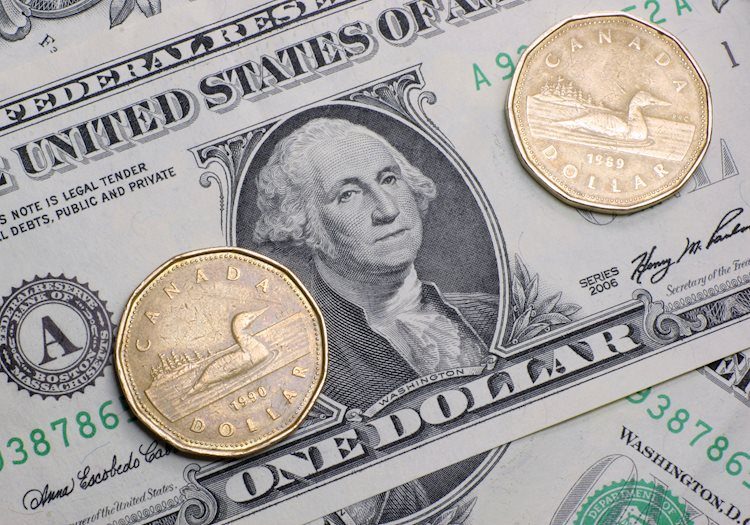- USD/CAD holds steady near 1.3645 in Wednesday’s early Asian session.
- Fed officials emphasized another gradual rate cut may be appropriate.
- Lower crude oil prices might exert some selling pressure on the Loonie.
The USD/CAD pair trades flat around 1.3645 amid the consolidation of the Greenback during the early Asian session on Wednesday. The US Federal Reserve (Fed) has emphasized that its approach to monetary policy easing will be guided by incoming economic data. Investors will take more cues from the US Consumer Price Index (CPI) data, which is due on Thursday.
Fed officials remain cautious and suggest another gradual rate cut may be appropriate. Boston Fed president Susan Collins noted on Tuesday that the central bank will likely need to cut interest rates further and the next phase of policy should focus on preserving the US economy.
Meanwhile, Atlanta Fed President Raphael Bostic stated on Tuesday that the jobs market is not showing signs of weakness, adding that despite significant progress on inflation, overall price figures have not yet hit target levels. New York Fed president John Williams said he strongly supported a reduction of 50 basis points (bps) at the last meeting and that two additional 25 bps cuts this year would be a “pretty reasonable representation of a base case.”
Investors will monitor the September’s Federal Open Market Committee (FOMC) meeting later on Wednesday, which might offer some hints about the size of rate reductions in November meetings. “Markets are all over the place. In the last 15 days, the probability of a 50 basis point cut in November has gone from over 60% to zero. November is next month,” noted El-Erian, the president of Queens’ College. The prospect of a smaller rate cut might boost the US Dollar (USD) against the Canadian Dollar (CAD).
On the other hand, a fall in crude oil prices could weigh on the commodity-linked CAD. Traders were disappointed as China’s top economic planner ended a highly anticipated briefing on Tuesday without new stimulus measures. It’s worth noting that Canada is the largest oil exporter to the United States (US), and lower crude oil prices tend to have a negative impact on the CAD value.
Canadian Dollar FAQs
The key factors driving the Canadian Dollar (CAD) are the level of interest rates set by the Bank of Canada (BoC), the price of Oil, Canada’s largest export, the health of its economy, inflation and the Trade Balance, which is the difference between the value of Canada’s exports versus its imports. Other factors include market sentiment – whether investors are taking on more risky assets (risk-on) or seeking safe-havens (risk-off) – with risk-on being CAD-positive. As its largest trading partner, the health of the US economy is also a key factor influencing the Canadian Dollar.
The Bank of Canada (BoC) has a significant influence on the Canadian Dollar by setting the level of interest rates that banks can lend to one another. This influences the level of interest rates for everyone. The main goal of the BoC is to maintain inflation at 1-3% by adjusting interest rates up or down. Relatively higher interest rates tend to be positive for the CAD. The Bank of Canada can also use quantitative easing and tightening to influence credit conditions, with the former CAD-negative and the latter CAD-positive.
The price of Oil is a key factor impacting the value of the Canadian Dollar. Petroleum is Canada’s biggest export, so Oil price tends to have an immediate impact on the CAD value. Generally, if Oil price rises CAD also goes up, as aggregate demand for the currency increases. The opposite is the case if the price of Oil falls. Higher Oil prices also tend to result in a greater likelihood of a positive Trade Balance, which is also supportive of the CAD.
While inflation had always traditionally been thought of as a negative factor for a currency since it lowers the value of money, the opposite has actually been the case in modern times with the relaxation of cross-border capital controls. Higher inflation tends to lead central banks to put up interest rates which attracts more capital inflows from global investors seeking a lucrative place to keep their money. This increases demand for the local currency, which in Canada’s case is the Canadian Dollar.
Macroeconomic data releases gauge the health of the economy and can have an impact on the Canadian Dollar. Indicators such as GDP, Manufacturing and Services PMIs, employment, and consumer sentiment surveys can all influence the direction of the CAD. A strong economy is good for the Canadian Dollar. Not only does it attract more foreign investment but it may encourage the Bank of Canada to put up interest rates, leading to a stronger currency. If economic data is weak, however, the CAD is likely to fall.
Read the full article here

